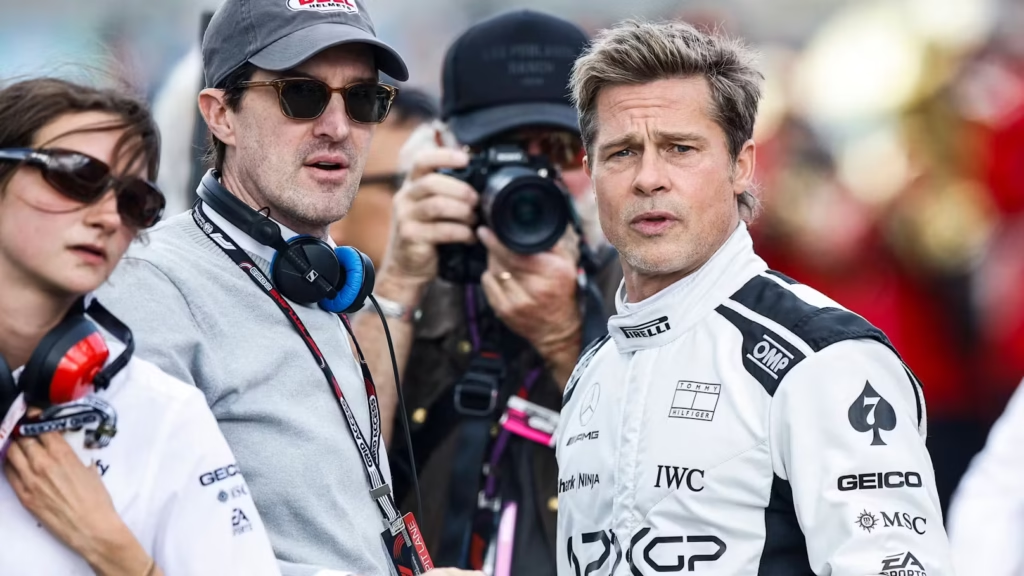
The Lights Go Green: Why an F1 Movie Matters Right Now
The buzz around a new F1 movie is more than a trend.
It’s a signal that motorsport’s most elite spectacle has finally crossed into mainstream cinematic culture.
After the surge of interest brought by modern streaming series and global races in iconic cities, the timing is perfect.
An F1 film has the potential to blend high-speed drama, real engineering stakes, and human emotion.
It’s a story about risk, precision, and ambition.
And it’s happening at 200 miles per hour.
For decades, racing films have tried to capture the sensation of speed and the human stories behind it.
But Formula 1 is a different beast entirely.
It’s the pinnacle of motorsport technology, the summit of driver skill, and the most cutthroat version of teamwork on wheels.
A well-made F1 movie can do something special.
It can make people feel the speed.
Understand the strategy.
And care about the characters behind the helmets.
The big question is simple.
What would make an F1 movie not just good, but unforgettable?
The DNA of Formula 1: More Than Just Speed
At its core, Formula 1 is a game of margins.
Millimeters in car setup.
Hundredths in lap times.
Split-second calls over team radio.
An F1 movie should honor those margins.
It should show how the technical complexity creates the human pressure that makes races compelling.
F1 is also global by design.
It travels from the sunlit streets of Monaco to the neon of Las Vegas and the night heat of Singapore.
Each circuit is a character, each pit wall a chessboard.
The film can bring this world to life with authenticity.
It can use real circuits, accurate car physics, and the visible tension that defines a race weekend.
But the most important thing is the people.
Drivers balancing fear and instinct.
Engineers balancing data and gut feel.
Team principals playing politics on and off the paddock.
The emotional engine of F1 is teamwork under pressure.
And that’s a universal story.
Casting the Grid: Heroes, Rivals, and the Team Behind the Scenes
A powerful F1 movie needs characters that reflect the ecosystem of the sport.
Not just the lead driver.
But the second driver fighting for recognition.
The strategist staring at numbers with a calm face and a racing heart.
The mechanic whose 1.8-second mistake becomes the turning point of the championship.
A compelling lead might be a driver on the cusp of greatness.
Talented but inconsistent.
Learning to trust the team and themselves.
Their rival is clinical and relentless, a champion with ice in their veins.
And anchoring the garage is a principal who understands the politics of the paddock as much as the mechanics of leadership.
The film can also do justice to diversity in motorsport.
Women in engineering roles.
Rising talents from underrepresented regions.
New pathways into the sport through sim racing and feeder series.
This isn’t just feel-good casting.
It’s reality.
And it’s the future of the grid.
Filming Speed: Making 200 MPH Feel Real
Capturing speed on film is hard.
Many movies either shake the camera or oversell the CGI.
An F1 movie should aim for authenticity.
Mount cameras low to the ground.
Use real cars or race-tuned mockups.
Record practical sound at trackside and inside the cockpit.
Keep the physics honest.
Use onboard camera angles that racing fans know and love, while framing them cinematically.
The goal is immersion.
Not just the blur of the straights.
But the violence of braking zones.
The ballet of tire management.
The heartbeat rhythm of a lap on the limit.
Think less arcade, more art.
Let the audience feel the G-forces through visual composition, sound design, and editing.
Engineering the Drama: Strategy as Story
Races are won before the lights go out.
They’re decided in simulation rooms, practice runs, and tire compound choices.
Strategy is the secret protagonist of every Grand Prix.
A good F1 movie should treat strategy like a thriller.
Do you undercut or overcut?
One stop or two?
Pit under the Safety Car or risk track position?
Translate this for the audience with smart visual cues.
Color-coded tire graphics.
Subtle overlays on fuel, tire wear, and weather probabilities.
Not as exposition dumps, but as breadcrumbs that sharpen the tension.
Even better, show how strategy evolves in real time.
Rain hits Sector 3.
The driver asks for inters.
The strategist hesitates.
The pit crew readies.
The rival commits.
One lap later, it’s chaos.
Make those decisions feel like heist-movie beats.
Precision.
Timing.
Consequences.
The Sound of Speed: Audio That Sells the Experience
If the car is the star, sound is its voice.
The best F1 engines sound like orchestras of violence and elegance.
Even with modern power units, the acoustic personality of each team and setup can be unique.
A brilliant score can blend synth textures with analog strings and motorsport samples.
Layer tire squeal with downshift pops, turbo whine, and DRS flutters.
Let silence be a weapon.
Cut the sound entirely for a heartbeat as the car dives into Eau Rouge.
Bring it crashing back at the crest.
The audience should feel the sound in their chest.
The Human Stakes: Fear, Failure, and Redemption
No F1 story works without vulnerability.
Drivers don’t just fight rivals; they fight themselves.
Confidence fluctuates.
Form comes and goes.
One crash can rattle a season.
A bad pit stop can shatter trust.
Show the fallout.
Let the character rebuild.
The best scenes might not be on track.
They’re in debrief rooms with dull lighting and raw honesty.
They’re in hotel lobbies at 1 a.m. after a lost podium.
They’re in the machine shop where a mechanic stays late to shave 30 grams off a component.
That’s the soul of the sport.
Real Circuits, Real Legends, Real Weight
An F1 movie gains power by anchoring itself in the mythos of the sport.
Circuits like Monaco, Monza, Silverstone, and Suzuka are not just locations.
They are cathedrals of speed.
Each has personality.
Monaco is precision under pressure.
Monza is flat-out courage.
Silverstone is heritage and airflow magic.
Suzuka is a driver’s circuit, a flowing test of rhythm.
Reference the legends carefully.
Show respect to icons without turning the film into a history lecture.
A helmet on a shelf.
A photo on the pit wall.
A corner name whispered like a prayer.
The Politics of the Paddock: Power Behind the Pit Wall
F1 is as much boardroom as it is pit lane.
An authentic film must recognize the political theater that runs alongside the racing.
Regulation changes that shift the balance of power.
Budget caps that force tough tradeoffs.
Protests, stewards’ decisions, and press conference games.
Teams play chess while pretending they’re playing checkers.
Let the audience see the tension between sporting purity and commercial reality.
How sponsorship dollars can shape a driver lineup.
How a technical directive can transform a season overnight.
How alliances form and break across the grid.
It’s intrigue with the hum of V6 engines in the background.
Training for the Edge: Athletes in Cockpits
Drivers are not just talented.
They are athletes trained for extreme conditions.
Heart rates spike and stay elevated.
Necks strain under 5G in fast corners.
Hydration is a battle.
Cognitive load is relentless.
Show the gym work.
Show the neck harness.
Show the reaction lights, the heat acclimation, the ice baths.
These details make the performances on Sunday feel superhuman yet earned.
The Rise of Data: From Telemetry to Storytelling
If the car is a rocket, telemetry is mission control.
Every lap generates data.
Temperature.
Brake pressure.
Throttle maps.
ERS deployment.
A film can transform these numbers into narrative.
Not by drowning the screen in charts.
But by choosing moments where data tells the truth the characters can’t.
A driver says the car feels fine.
The data shows rear tire temps spiking.
Trust the numbers or trust the human.
That friction is great cinema.
Fans, Flags, and the Global Circus
One of the joys of modern F1 is its fan energy.
Grandstands become seas of color and country flags.
Campgrounds turn into temporary cities.
Street races bring the grid to the people.
Include the fans.
The traveling superfans.
The first-time ticket holders.
The kids with team caps oversized on their heads.
That emotional chorus is part of the spectacle.
Digital fandom matters too.
Race edits on social media.
Memes between teams.
Live timing apps with thousands of watchers.
A clever film can nod to this modern ecosystem without feeling gimmicky.
Women in the Paddock: Real Roles, Real Impact
The sport is changing, and the film should reflect it.
Women serve as race engineers, performance analysts, mechanics, and team leaders.
Their presence is not token.
It’s essential.
A multidimensional character in a lead technical role can ground the story.
She masters the data.
She commands respect.
She makes the call that flips a race on its head.
Audiences will believe it because it’s already true.
The Rookie and the Veteran: A Timeless F1 Dynamic
Some rivalries write themselves.
A hungry rookie storms into the sport with fearless aggression.
A seasoned veteran holds the line with mastery and control.
Put them in the same team, and sparks fly.
Team orders become moral dilemmas.
Upgrades become points of contention.
The rookie learns the craft.
The veteran remembers the fire.
This dynamic gives natural arcs that can intersect beautifully with the championship fight.
Weather as a Character: When the Sky Rolls the Dice
Rain is pure chaos in F1.
It scrambles pace.
It rewards bravery and punishes indecision.
Cameras love it.
Spray hanging in the air.
Wipers hammering.
Hands dancing over wheel dials.
A race that starts dry and goes wet is cinema gold.
Make the clouds part of the script.
Make the radar a suspense device.
The Pit Stop Ballet: Two Seconds of Truth
Pit stops are lightning storms choreographed by humans.
Jack up.
Wheel off.
Wheel on.
Release.
Every role is practiced hundreds of times.
But race day adds the tremor of adrenaline.
A single sticky wheel nut becomes heartbreak.
A perfect double-stack becomes legend.
Slow this down with macro close-ups and then snap back to real time.
Let viewers feel the choreography, the danger, and the stakes.
Safety and Courage: Progress That Saves Lives
Modern F1 is safer than ever.
But it’s never safe.
The Halo device changed the game and saved lives.
Barriers evolved.
Car structures absorb forces that would have been unthinkable decades ago.
A respectful film acknowledges past tragedies while focusing on the innovations that let today’s heroes walk away from enormous impacts.
It’s not just spectacle.
It’s responsibility.
The Business of Speed: Money, Media, and Markets
Teams are companies with global footprints.
Factory headcounts rival startups.
Supply chains stretch across continents.
Aerodynamic parts are treated like crown jewels.
A sponsor logo means millions in development.
A storyline that follows funding pressures and media narratives gives realism.
Because in F1, a tenth of a second can be worth more than a small fortune.
Ethics and Edges: Where Rules Meet Innovation
Formula 1 thrives on the boundary between what’s allowed and what’s possible.
Double diffusers.
Flexti-wings.
Ground effect debates.
Fuel flow scandals.
A film can introduce these concepts without getting lost in jargon.
Use simple metaphors.
Show real consequences.
Innovation isn’t just cleverness.
It’s risk with a stopwatch ticking.
Global Cities, Local Stories
Each Grand Prix carries a local flavor.
Street circuits transform skylines into chicanes.
Traditional tracks bring decades of memory.
Cultural backdrops give the story texture.
Let the movie breathe between races.
Food markets at dawn.
Hotel lobbies after midnight.
Mechanics rolling cargo boxes under airport floodlights.
The circus never stops moving.
Authenticity Checklist: What Fans Will Notice
If you get F1 wrong, fans will call it instantly.
So here’s what the movie must nail.
Steering wheels with realistic dials.
Team radio with professional clarity and code phrases.
Marshals and flag rules done right.
Paddock security and media zones consistent with race weekends.
Correct tire colors for compounds.
DRS zones correctly placed.
Grid procedures accurate to FIA standards.
It’s the little details that win trust.
The Emotional Lap: Structuring the Story
Structure the film like a race weekend.
Friday is discovery.
Saturday is pressure.
Sunday is destiny.
Mirror that rhythm in the character arcs.
Start wide.
Narrow to a few core relationships.
Build tension with qualifying stakes.
Let Act Three play out like a Grand Prix with setup, twist, and last-lap catharsis.
Don’t force melodrama.
Let the stopwatch do the talking.
Cinematic Influences Without the Copy
Great racing films exist, but an F1 movie should have its own identity.
Borrow the tactile realism of sports dramas.
Blend it with the precision of heist-film pacing.
Add the grandeur of travel cinema.
Keep the heart front and center.
The audience should walk out feeling like they’ve lived a season.
Not just watched one.
Technology as Character: Wind Tunnels and Sim Rigs
Bring the audience into the factory.
Wind tunnels humming in clinical rooms.
Computational fluid dynamics projected on glass walls.
Simulators where drivers grind late into the night.
Development tokens and upgrade packages explained through story.
Make the aero maps visible.
Make the gains tangible.
One new front wing can change a career.
The Social Pulse: How F1 Lives Online
Modern fandom is hyperconnected.
Clips go viral within minutes of a decisive move.
Team banter pulls in casual audiences.
Influencers walk the paddock.
Memes soften rivalries and intensify them at once.
Use this as texture, not crutch.
Tasteful integration of social media can show how the sport breathes between races.
The Heart of the Grid: Why We Watch
At the end of the day, F1 is a paradox.
It’s brutally technical and deeply human.
It’s ruthless and romantic.
It’s a meritocracy built on billions and belief.
An F1 movie that embraces those contradictions will resonate widely.
It will respect old fans and welcome new ones.
Because what we’re chasing isn’t just speed.
It’s meaning at the limit.
Essential Links and Resources for New Fans
If you’re curious about schedules, official rules, and live updates, start with the Formula 1 official site.
For safety regulations and technical directives, explore the FIA.
Want to learn track history and layouts, check Circuit Monza and Silverstone.
To get a sense of the atmosphere at iconic events, browse the Monaco tourism page.
And for English-language coverage with analysis and features, established motorsport outlets provide deep dives throughout the season.
Potential Set Pieces We Need to See
A tense qualifying final run under fading light.
A wet-dry race with a risky undercut that either makes or breaks the season.
A double-stack pit stop under Safety Car pressure.
A last-lap defense with a single percent of battery left.
A post-race protest that shifts the championship standings overnight.
A late-season upgrade that flips the competitive order.
What an F1 Movie Can Teach Without Preaching
Perseverance under pressure is a skill.
Feedback is a two-way street between driver and team.
Marginal gains matter more than heroics.
Preparation turns chaos into opportunity.
And sometimes, the bravest choice is lifting the throttle.
Story Seeds for a Standout F1 Film
Rookie joins a midfield team with a visionary engineer and a cash-strapped factory.
They gamble on a radical aero concept.
Mid-season heat exposes weaknesses.
A late upgrade brings the car alive.
The veteran teammate must decide whether to play wingman or go rogue.
A title challenger from a top team lurks.
The final race isn’t just about the podium.
It’s about survival, loyalty, and legacy.
How to Balance Realism and Spectacle
Let the racing be real.
Let the human stakes be heightened.
Avoid miracle comebacks that defy physics.
Earn every twist.
Trust the intelligence of the audience.
They will reward you for it.
The Final Lap Feel Without the Final Word
An F1 movie doesn’t need to tie every ribbon.
A season ends.
Another begins.
Leave the audience with the hum of engines in their ears.
Leave them wanting the next race.

Also Read: Rihanna




